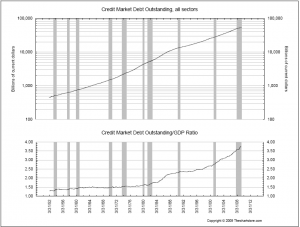 Reading the news has never been the best way to inspire optimism. This phenomenon has never been more true than it is today for financially astute people that are aware of causes and consequences. In a recent press conference, the US President was touting a new blitz of government programs to get the US economy “back on track.” On the surface, this seems like a laudable goal, until you consider what is meant by getting the economy back on the track it was previously traveling.
Reading the news has never been the best way to inspire optimism. This phenomenon has never been more true than it is today for financially astute people that are aware of causes and consequences. In a recent press conference, the US President was touting a new blitz of government programs to get the US economy “back on track.” On the surface, this seems like a laudable goal, until you consider what is meant by getting the economy back on the track it was previously traveling.
It is not a secret that the precipitous collapse of the US economy was created by a prolific expansion in debt financed investment and consumption. This helix of credit escalated asset prices upward in a speculative bubble until they were so high new buyers could no longer be found to continue paying the ever increasing prices. As the prices contracted, many people and funds with overleveraged positions found themselves ‘upside down’ when values plunged below the purchase prices. This downward vortex was fed further by people who had purchased home mortgages that they did not have the capacity to afford based on the assumption that their homes would continually increase in value. As prices fell, foreclosures increased, which further depressed prices, which created more foreclosures.
 Most people of even an elementary education level intuitively know that this much debt cannot be undertaken without a tremendous level of risk. True economic growth is fueled by increases in the level of productivity for labor output that allows a nation to increase the amount of output with the same amount of input. Misalignments of prices from market manipulations frequently disrupt this natural progression of labor productivity increases with boom and bust cycles. The unfortunate fallout of this phenomenon is that politicians are frequently more interested in creating an artificial ‘boom’ that they can claim credit for than fostering genuine economic growth
Most people of even an elementary education level intuitively know that this much debt cannot be undertaken without a tremendous level of risk. True economic growth is fueled by increases in the level of productivity for labor output that allows a nation to increase the amount of output with the same amount of input. Misalignments of prices from market manipulations frequently disrupt this natural progression of labor productivity increases with boom and bust cycles. The unfortunate fallout of this phenomenon is that politicians are frequently more interested in creating an artificial ‘boom’ that they can claim credit for than fostering genuine economic growth
For evidence of this phenomenon, one must look no further than the efforts of the current Presidential administration to re-inflate the debt bubble as a means of artificially propping up the economy in absence of a discernable improvement in the underlying fundamentals. After many months of campaigning against traditional populist straw dogs of “Greed” and “Corporate America” the people currently in charge are repeating the exact same actions that perpetuated the last debt bubble.
For example, one of the ‘fixes’ proposed was to increase allowable debt levels so that more people could refinance their homes. Another round of government sponsored programs was to give away taxpayer money to new home buyers and new car buyers. In each of these cases, the government is directly encouraging further indebtedness to finance short-term consumption. The philosophy guiding these actions is a belief that this debt-financed consumption will “get the economy moving” again.
Looking at the total credit outstanding across all sectors as a ratio of Gross Domestic Product shows a startling trend of increasing indebtedness. Even more startling is the fact that the recent economic collapse served as little more than a speed bump in this upward trajectory, and all signs point to the current administration accelerating the debt bubble with ballooning record budget deficits and fiscal policy directed at encouraging debt to stimulate short term consumption.
The intense irony of this situation is that it is a carbon-copy repeat of the behaviors that caused the current financial mess in the first place. Sustained economic growth can only come from production and innovation. These things cannot be produced by government fiat or market manipulations. They must emerge from individual people having the right incentives to create valuable products and services. As long as the government continues to engage in ‘smoke and mirrors’ forms of market manipulations and debt bubble inflation, it is not very likely that the necessary conditions for a market recover will emerge.
Financial independence is closer than you think. Buy your Early Bird ticket to the Meet the Masters of Income Property Investing educational event before February 14 to qualify for a steep discount on tickets.
The Solomon Success Team
Flickr / Sincere Stock

